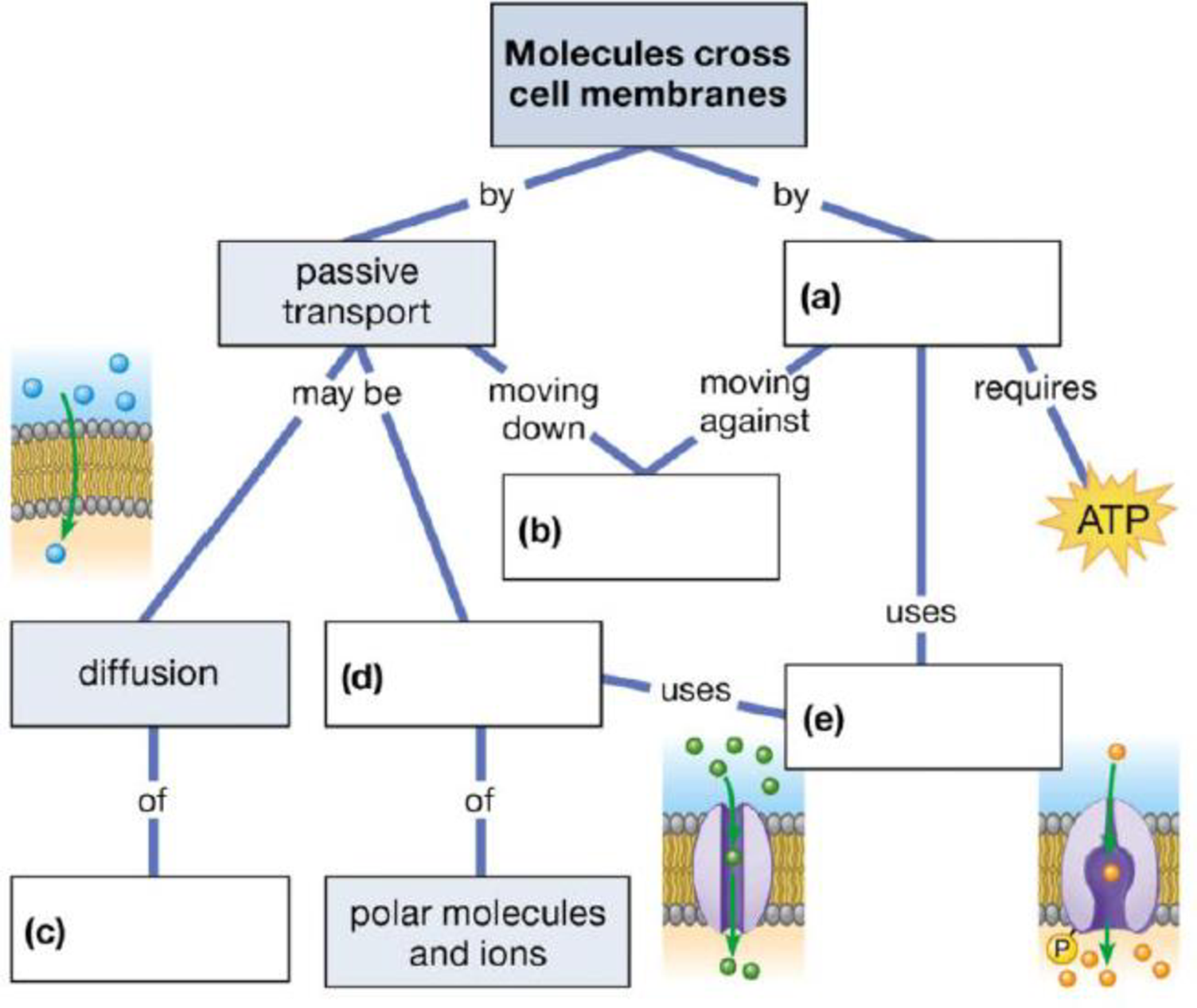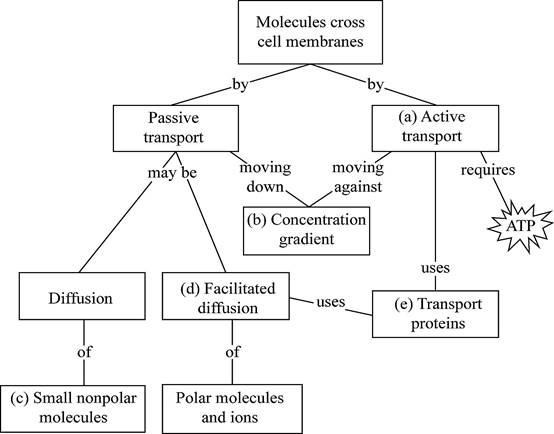
Concept explainers
Fill in the following concept map to review the processes by which molecules move across membranes.

To complete: The given map showing the process by which the molecules move across the cell membrane.
Introduction:
The plasma membrane is selectively permeable, and it allows the movement of substances in and out of the cells. The two main types of transport are active transport and passive transport.
Answer to Problem 1CC
Pictorial representation: The Fig.1 shows the movement of molecules between cells through the cell membranes.

Fig.1: The process involved in the transport of molecules across the cell membrane
Explanation of Solution
(a)
Correct answer: Active transport
Explanation: Active transport is an energy-dependent process in which the molecules are moved from a region of lower concentration to a region of higher concentration against their concentration gradient, and it requires energy in the form of ATP. Hence, the correct answer is Active transport.
(b)
Correct answer: Concentration gradient
Explanation: The concentration gradient is the difference in the concentration of the solutes. Active transport moves the molecules against their concentration gradient, whereas passive transport moves the solutes along with their concentration gradient. Hence, the correct answer is Concentration gradient.
(c)
Correct answer: Small nonpolar molecules
Explanation: A molecule is said to be nonpolar when there is a symmetrical arrangement of polar bonds in a complex molecule or if there is an equal sharing of electrons between the two atoms. These small nonpolar molecules can diffuse across the membrane. Example: Oxygen and carbon dioxide are the two nonpolar molecules that can undergo simple diffusion. Hence, the correct answer is Small nonpolar molecules.
(d)
Correct answer: Facilitated diffusion
Explanation: Facilitated diffusion is a passive transport where the molecules diffuse across the plasma membrane with the help of the membrane proteins such as carriers and channels. This transport does not require energy, and it moves the solute down the concentration gradient. Hence, the correct answer is Facilitated diffusion.
(e)
Correct answer: Transport proteins
Explanation: Transport proteins are a type of proteins used to move the substances across the cell membrane. They are mainly of two types: channel proteins and carrier proteins. Channel proteins are used to transport ions in and out of the cell, and carrier proteins are used to transport macromolecules, ions, and small molecules by changing their shape or conformation. Hence, the correct answer is Transport proteins.
Want to see more full solutions like this?
Chapter 5 Solutions
Campbell Biology: Concepts & Connections (8th Edition)
- 18. Watch this short youtube video about SARS CoV-2 replication. SARS-CoV-2 Life Cycle (Summer 2020) - YouTube.19. What is the name of the receptor that SARS CoV-2 uses to enter cells? Which human cells express this receptor? 20. Name a few of the proteins that the SARS CoV-2 mRNA codes for. 21. What is the role of the golgi apparatus related to SARS CoV-2arrow_forwardState the five functions of Globular Proteins, and give an example of a protein for each function.arrow_forwardDiagram of check cell under low power and high powerarrow_forward
- a couple in which the father has the a blood type and the mother has the o blood type produce an offspring with the o blood type, how does this happen? how could two functionally O parents produce an offspring that has the a blood type?arrow_forwardWhat is the opening indicated by the pointer? (leaf x.s.) stomate guard cell lenticel intercellular space none of thesearrow_forwardIdentify the indicated tissue? (stem x.s.) parenchyma collenchyma sclerenchyma ○ xylem ○ phloem none of thesearrow_forward
- Where did this structure originate from? (Salix branch root) epidermis cortex endodermis pericycle vascular cylinderarrow_forwardIdentify the indicated tissue. (Tilia stem x.s.) parenchyma collenchyma sclerenchyma xylem phloem none of thesearrow_forwardIdentify the indicated structure. (Cucurbita stem l.s.) pit lenticel stomate tendril none of thesearrow_forward
- Identify the specific cell? (Zebrina leaf peel) vessel element sieve element companion cell tracheid guard cell subsidiary cell none of thesearrow_forwardWhat type of cells flank the opening on either side? (leaf x.s.) vessel elements sieve elements companion cells tracheids guard cells none of thesearrow_forwardWhat specific cell is indicated. (Cucurbita stem I.s.) vessel element sieve element O companion cell tracheid guard cell none of thesearrow_forward
 Human Physiology: From Cells to Systems (MindTap ...BiologyISBN:9781285866932Author:Lauralee SherwoodPublisher:Cengage Learning
Human Physiology: From Cells to Systems (MindTap ...BiologyISBN:9781285866932Author:Lauralee SherwoodPublisher:Cengage Learning Human Biology (MindTap Course List)BiologyISBN:9781305112100Author:Cecie Starr, Beverly McMillanPublisher:Cengage Learning
Human Biology (MindTap Course List)BiologyISBN:9781305112100Author:Cecie Starr, Beverly McMillanPublisher:Cengage Learning Concepts of BiologyBiologyISBN:9781938168116Author:Samantha Fowler, Rebecca Roush, James WisePublisher:OpenStax College
Concepts of BiologyBiologyISBN:9781938168116Author:Samantha Fowler, Rebecca Roush, James WisePublisher:OpenStax College Anatomy & PhysiologyBiologyISBN:9781938168130Author:Kelly A. Young, James A. Wise, Peter DeSaix, Dean H. Kruse, Brandon Poe, Eddie Johnson, Jody E. Johnson, Oksana Korol, J. Gordon Betts, Mark WomblePublisher:OpenStax College
Anatomy & PhysiologyBiologyISBN:9781938168130Author:Kelly A. Young, James A. Wise, Peter DeSaix, Dean H. Kruse, Brandon Poe, Eddie Johnson, Jody E. Johnson, Oksana Korol, J. Gordon Betts, Mark WomblePublisher:OpenStax College Biology: The Dynamic Science (MindTap Course List)BiologyISBN:9781305389892Author:Peter J. Russell, Paul E. Hertz, Beverly McMillanPublisher:Cengage Learning
Biology: The Dynamic Science (MindTap Course List)BiologyISBN:9781305389892Author:Peter J. Russell, Paul E. Hertz, Beverly McMillanPublisher:Cengage Learning





